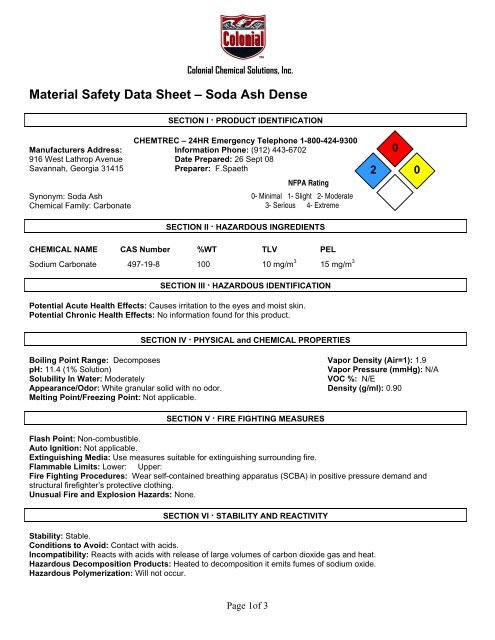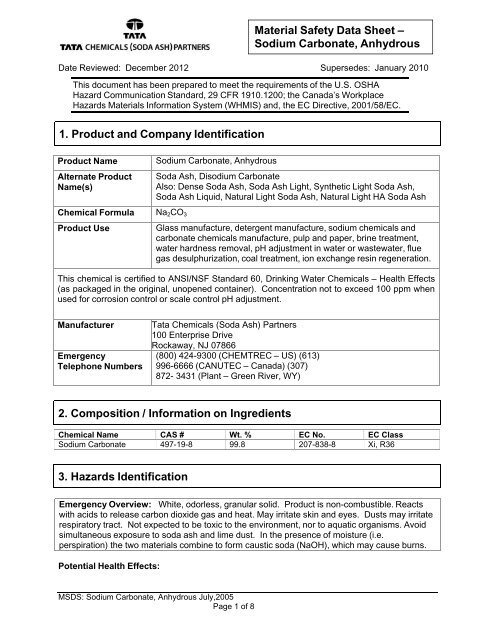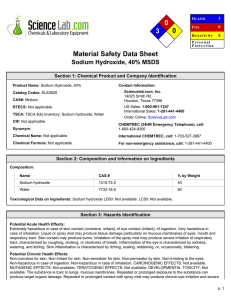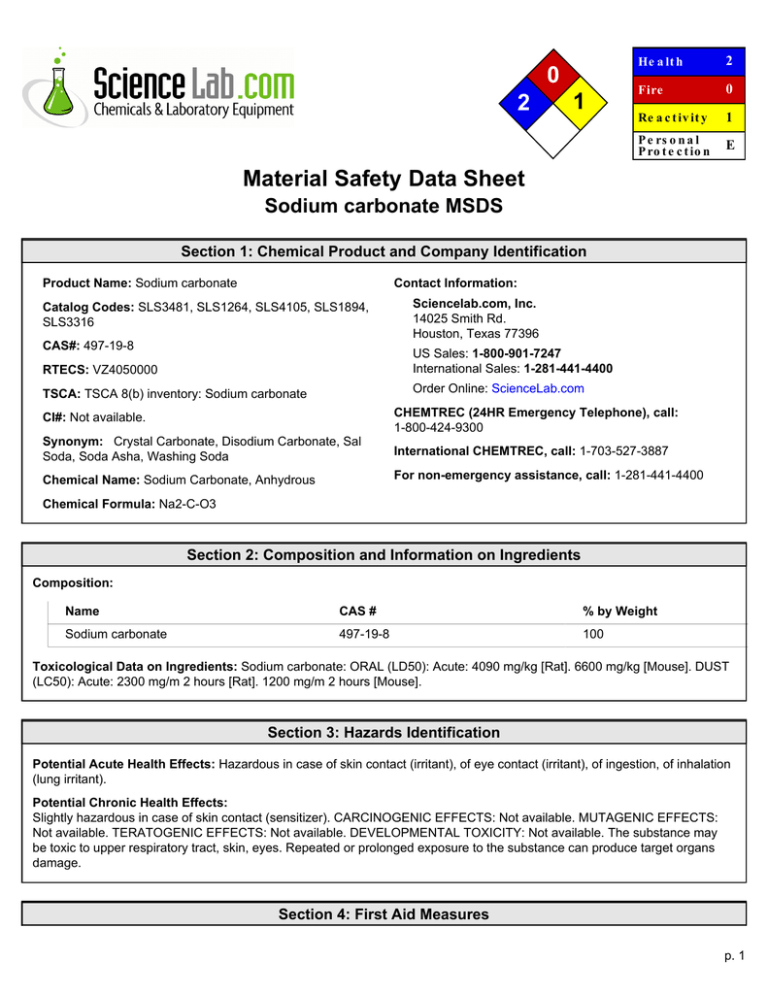Sodium carbonate hazard
Home » chemical » Sodium carbonate hazard >Sodium carbonate hazard
Sodium Carbonate Hazard. Mixtures of sodium carbonate or graphite with lithium carbonate sodium chloride or sodium fluoride are very effective for sodium. Sodium hydrogensulfateVI bisulfate Solid and concentrated solution If 025 M or more CORROSIVE. Pump back into system if possible. Section 8 - Exposure Controls Personal Protection Engineering Controls.

It is an essential raw material in glass chemicals detergents and other important industrial products. Due to its strong corrosive qualities exposure to sodium hydroxide in its solid or solution form can cause skin and eye irritation according to the US. Contains about 5 sodium hydroxide 1 potassium hydroxide 02 silicon dioxide 14 19 water and the remainder calcium hydroxide it is used to absorb carbon dioxide. Facilities storing or utilizing this material should be equipped with an eyewash facility and a safety shower. Sodium sulfateVI is an approved food additive E514 as is the potassium salt E515. High-temperature sodiumsulfur batteries operating at 300350 C have been commercially applied for large-scale energy storage and conversion.
Toxic metal salts such as Silver chloride Cadmium sulfate Mercury acetate Barium carbonate Lead acetate etc.
We will be publishing Issue 1 of The School STEM Technician at noon on the 1st December 2021 via the SSERC website. We will be publishing Issue 1 of The School STEM Technician at noon on the 1st December 2021 via the SSERC website. Sodium-ion batteries SIBs are considered as the best candidate power sources because sodium is widely available and exhibits similar chemistry to that of LIBs. In 1998 in terms of. It is an essential raw material in glass chemicals detergents and other important industrial products. Food Chemical Codex FCC.
 Source: ehs.com
Source: ehs.com
It is an essential raw material in glass chemicals detergents and other important industrial products. Handbook of Reactive Chemical Hazards. Lithium Carbonate Extended-Release Tablets USP contain lithium carbonate a white odorless alkaline powder with molecular formula Li 2 CO 3 and molecular weight 7389. Contains about 5 sodium hydroxide 1 potassium hydroxide 02 silicon dioxide 14 19 water and the remainder calcium hydroxide it is used to absorb carbon dioxide. Dispose of spilled material and neutralization residues in.

Because this is intended as a first introduction the interpretation should be restricted to developing the word equation as a summary of what has happened. Also known as caustic soda and caustic potash. In this case the chemical hazard level is slightly higher since copperII carbonate is HARMFUL. Precipitated calcium carbonate CAS. It is strongly acidic because of acidic hydrogen in NaHSO.

CAS 1310-73-2 is listed on the TSCA. Sodium sulfateVI is an approved food additive E514 as is the potassium salt E515. High-temperature sodiumsulfur batteries operating at 300350 C have been commercially applied for large-scale energy storage and conversion. Using sodium metal beryllium. Pump back into system if possible.

Precipitated calcium carbonate CAS. Sodium hydroxide is a highly caustic base and alkali that decomposes proteins at ordinary ambient temperatures and may cause severe chemical burnsIt is highly soluble in water and readily. Mixtures of sodium carbonate or graphite with lithium carbonate sodium chloride or sodium fluoride are very effective for sodium. In 1998 in terms of. Recently sodiated layer transition metal oxides phosphates and organic compounds have been introduced as cathode materials for SIBs.
 Source: yumpu.com
Source: yumpu.com
O is known as Glaubers salt. 497-19-8 Sodium carbonate. Wear eye protection face protection. Sodium hydrogensulfateVI bisulfate Solid and concentrated solution If 025 M or more CORROSIVE. Therefore SIBs are promising next-generation alternatives.
 Source: yumpu.com
Source: yumpu.com
Section 15 - Regulatory Information US Federal Regulations TSCA Section 8b. 471-34-1 is produced industrially by the decomposition of limestone to calcium oxide followed by subsequent recarbonization or as a by-product of the Solvay process which is used to make sodium carbonate. Butterworth-Heinemann Ltd 1990 p. DANGEROUS GOODS Sodium cyanide solid is classified for physicochemical hazards and specified as dangerous in the Australian Code for the Transport of Dangerous Goods by Road and Rail ADG Code 7th Edition. Also known as caustic soda and caustic potash.
 Source: studylib.net
Source: studylib.net
Containers must be tightly closed to prevent the conversion of NaOH to sodium carbonate by the CO2 in air. Sodium sulfateVI is an approved food additive E514 as is the potassium salt E515. Sodium hydroxide is a highly caustic base and alkali that decomposes proteins at ordinary ambient temperatures and may cause severe chemical burnsIt is highly soluble in water and readily. Using sodium metal beryllium. Sodium hydrogen carbonate is a constituent of backing powder and is applied in textile and leather industries and in soap and cleanser production.
 Source: www2.atmos.umd.edu
Source: www2.atmos.umd.edu
Precipitated calcium carbonate CAS. Butterworth-Heinemann Ltd 1990 p. 1 FDC Red No. Contain spill isolate hazard area and deny entry. The extraction process keeps the carbonate very close to its original state of purity and delivers a finely ground product either in dry or slurry form.
 Source: studylib.net
Source: studylib.net
Sodium carbonate CAS 497-19-8 anhydrous for analysis EMSURE ISO - Find MSDS or SDS a COA data sheets and more information. Sodium carbonate CAS 497-19-8 anhydrous for analysis EMSURE ISO - Find MSDS or SDS a COA data sheets and more information. Wear eye protection face protection. Each capsule for oral administration contains Lithium Carbonate USP 150 mg 300 mg or 600 mg and the following inactive ingredients. Due to its strong corrosive qualities exposure to sodium hydroxide in its solid or solution form can cause skin and eye irritation according to the US.
 Source: studylib.net
Source: studylib.net
Butterworth-Heinemann Ltd 1990 p. It is strongly acidic because of acidic hydrogen in NaHSO. Sodium hydroxide may be applied to prevent clogging of sewer pipes and sodium carbonate is applied in water purification to neutralize acids. Sodium hydroxide is a highly caustic base and alkali that decomposes proteins at ordinary ambient temperatures and may cause severe chemical burnsIt is highly soluble in water and readily. Handbook of Reactive Chemical Hazards.
If you find this site beneficial, please support us by sharing this posts to your own social media accounts like Facebook, Instagram and so on or you can also save this blog page with the title sodium carbonate hazard by using Ctrl + D for devices a laptop with a Windows operating system or Command + D for laptops with an Apple operating system. If you use a smartphone, you can also use the drawer menu of the browser you are using. Whether it’s a Windows, Mac, iOS or Android operating system, you will still be able to bookmark this website.